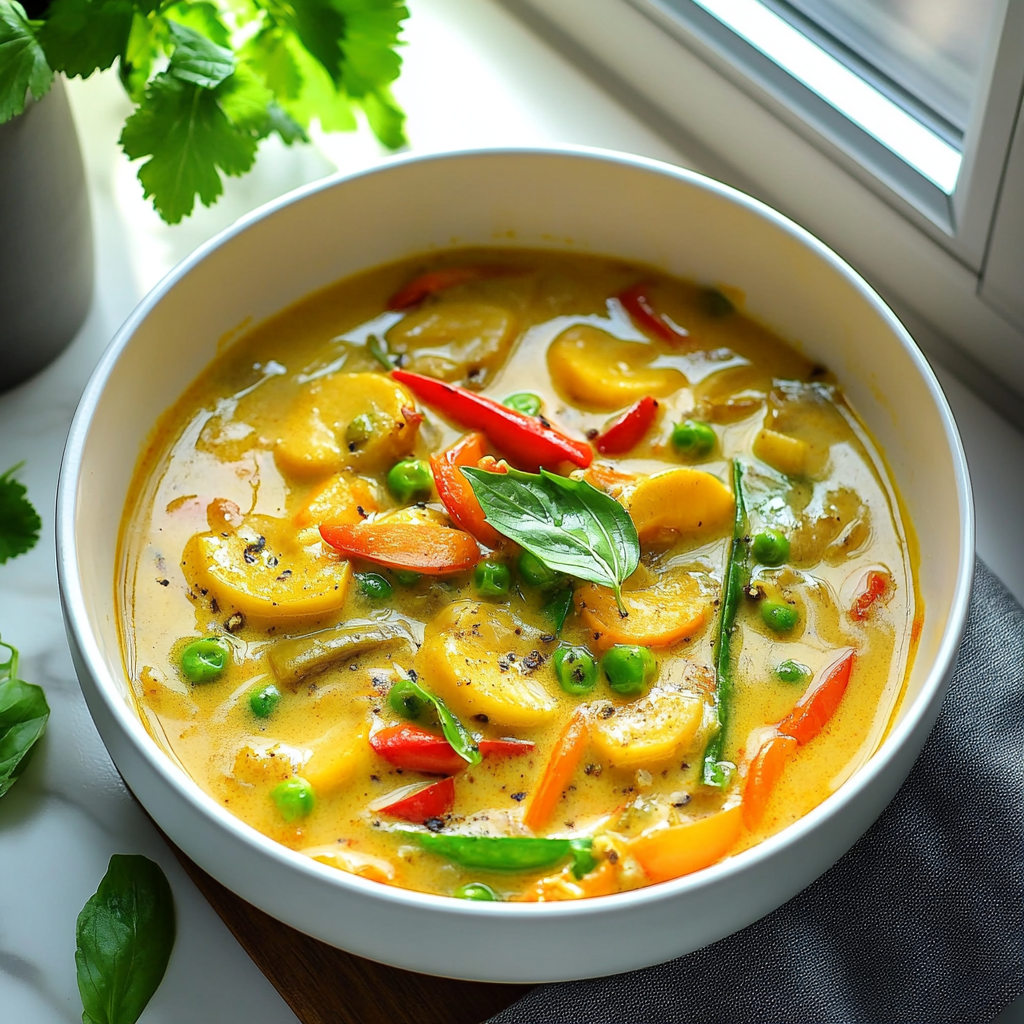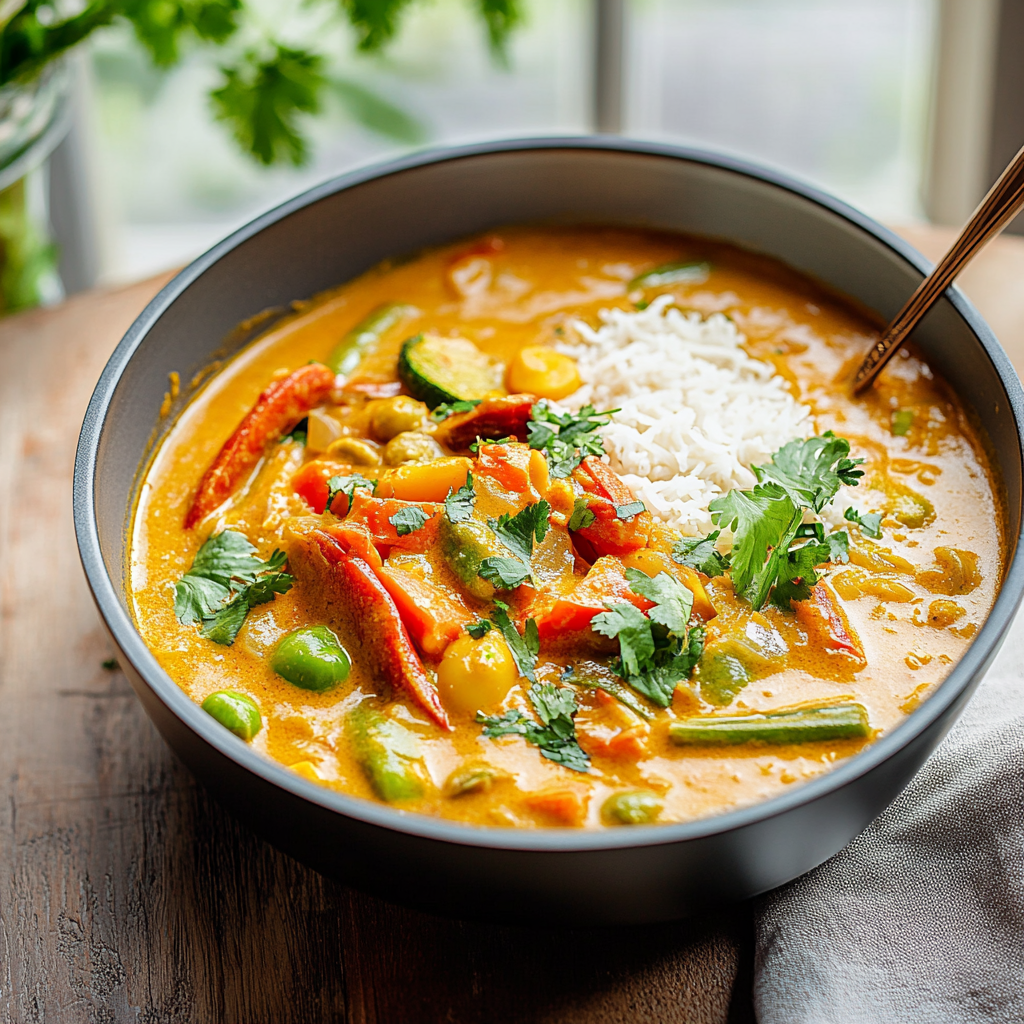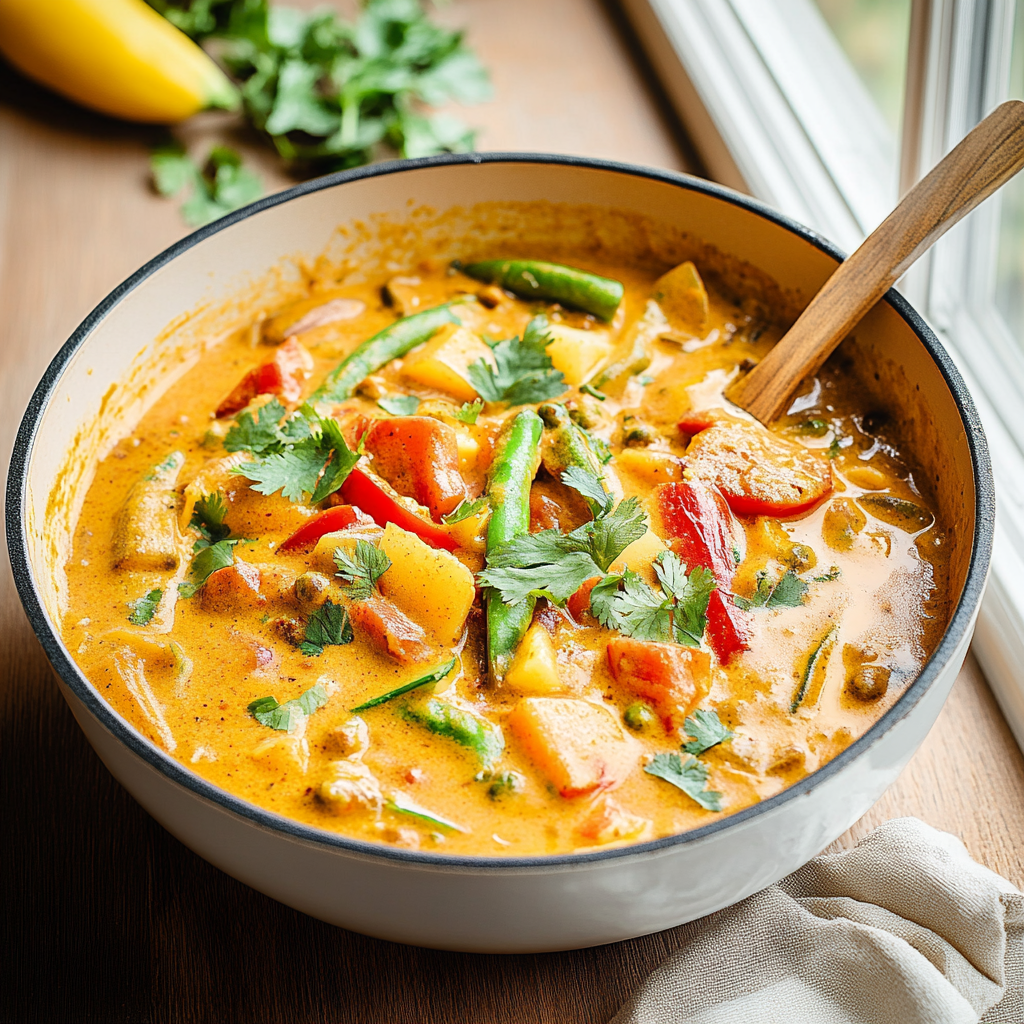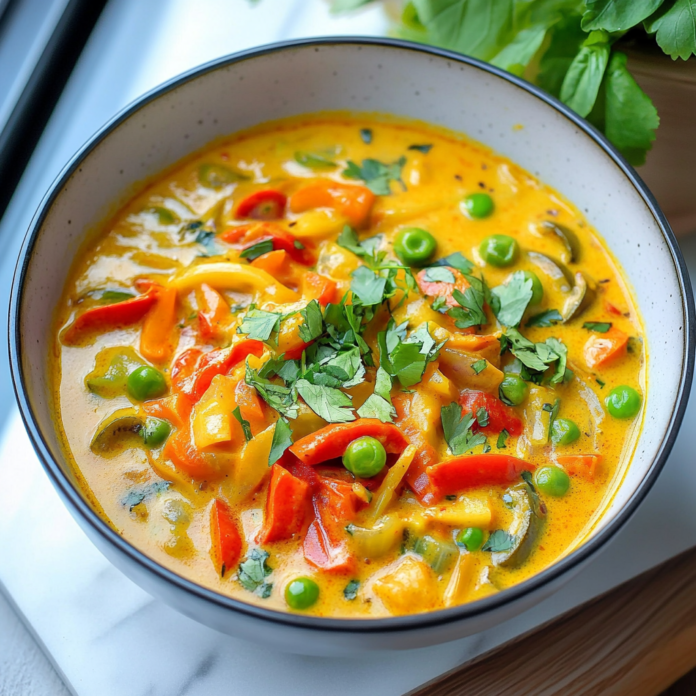**Focus Keyphrase: ** Vegan Coconut Curry with Vegetables
**Short SEO Title: ** Delicious Vegan Coconut Curry with Fresh Vegetables
**Short Image SEO Title: ** Vegan Coconut Curry with Vegetables
**Image SEO Description: ** **Meta Description: **
**Multiple Focus Keyphrase Synonyms: ** Vegan curry, coconut vegetable curry, plant-based curry, dairy-free curry, vegetable curry recipe
**Multiple Tags: ** Introduction and Quick Summary
Are you in the mood for a warm and comforting dish that’s both nourishing and delicious? Look no further than this Vegan Coconut Curry with Vegetables! This delightful recipe combines the creamy richness of coconut milk with a medley of colorful vegetables, creating a culinary experience that’s both satisfying and nutritious. Packed with flavor and made from wholesome ingredients, this vegan curry is perfect for those who want to enjoy a meat-free meal without sacrificing taste.
In this article, we will guide you through every step of preparing this vibrant dish. From selecting the freshest vegetables to crafting the perfect blend of spices that elevate the flavors, you’ll find everything you need to know right here. Whether you’re cooking for yourself or entertaining guests, this hearty vegan coconut curry will impress everyone at your table. Plus, it’s simple enough for weeknight dinners yet elegant enough for special occasions.
Stay tuned as we dive into the main ingredients needed for this recipe and provide you with detailed instructions on how to prepare it. You’ll also discover some serving suggestions and storage tips to make the most out of your delicious creation. Get ready to enjoy a bowl of comfort that is both healthy and fulfilling!
Main Ingredients
Coconut Milk
Coconut milk is the star ingredient in this vegan coconut curry. It adds creaminess and depth while providing essential fats that keep you satisfied. For this recipe, use one can (about 400 ml) of full-fat coconut milk for extra richness. If you’re looking for a lighter version, you can opt for light coconut milk; however, it may alter the creaminess slightly.
Mixed Vegetables
Using a variety of vegetables not only enhances the flavor but also boosts nutrition. For our recipe, you’ll need about 4 cups of mixed vegetables such as bell peppers, carrots, broccoli, and snap peas. Feel free to customize based on what’s in season or what you have on hand! Aim for a colorful mix to make your dish visually appealing.
Onion
Onions are fundamental in building flavor profiles in many dishes. One medium onion will suffice for this recipe; chop it finely to ensure it cooks evenly. Onions add sweetness when sautéed and create a savory base that complements the other ingredients beautifully.
Garlic
Garlic brings an aromatic punch to your dish. Use three cloves of fresh garlic minced finely for maximum flavor infusion. Garlic has numerous health benefits too; it’s known to boost immunity and add depth to savory dishes.
Ginger
Fresh ginger adds a zesty kick that pairs perfectly with coconut milk’s sweetness. Use about one tablespoon of freshly grated ginger in this recipe; its warmth helps balance the flavors while giving your curry an exotic flair.
Spices
A blend of spices elevates your vegan coconut curry into something extraordinary. For this recipe, you’ll need two teaspoons each of ground cumin and coriander along with one teaspoon of turmeric and red chili powder (adjust based on your spice preference). These spices create an aromatic foundation that enhances each bite.
Vegetable Broth
For added flavor depth without any animal products, use vegetable broth as your cooking liquid. About 2 cups will work well in this recipe; it helps meld all the flavors together while keeping everything moist during cooking.

How to Prepare Vegan Coconut Curry with Vegetables
Step 1: Sauté Aromatics
Start by heating two tablespoons of oil in a large skillet over medium heat. Add the chopped onion and sauté until translucent (about 5-7 minutes). This process releases natural sugars from the onions which builds sweetness into your dish. Next, add minced garlic and grated ginger; continue sautéing until fragrant—around 1-2 minutes should suffice.
As these aromatics develop flavor, be sure to stir occasionally so they don’t burn; burnt garlic can lead to an unpleasant bitterness throughout your dish.
Step 2: Add Spices
Once your aromatics are ready, it’s time to introduce the spices! Stir in ground cumin, coriander, turmeric, and red chili powder into the onion mixture—this allows them to toast slightly which intensifies their flavors even more.
Cook these spices together for about one minute while stirring continuously; you’ll notice their aroma will start wafting through your kitchen! This step is crucial as it lays down robust notes within your vegan coconut curry base.
Step 3: Incorporate Vegetables
Now it’s time to introduce those colorful mixed vegetables! Add them directly into the pan along with salt (to taste) before pouring in vegetable broth—this helps steam them perfectly while ensuring they absorb all those rich flavors.
Stir well so every piece gets coated nicely with spice mixture before bringing everything up to a gentle simmer on low heat (covering helps cook faster). Cook until veggies become tender but still crisp—around 10-12 minutes should do depending on how thickly you’ve cut them!
Step 4: Finish With Coconut Milk
After your veggies have softened adequately according to preference (keep an eye on them!), pour in one can (400 ml) of full-fat coconut milk into skillet—stirring gently ensures even distribution throughout entire dish!
Increase heat slightly until mixture reaches boil then reduce back down low once bubbling begins again; let simmer uncovered for another 5-10 minutes allowing all components meld harmoniously together while thickening sauce slightly too!
Taste test at this stage—add additional salt if needed or adjust spice levels according personal preference! If desired add fresh lime juice here before serving too!

Serving and Storing Tips
Serving Suggestions
Serve warm over steamed rice or quinoa—this provides great texture contrast against creamy sauce while adding nutritional benefits! Garnish each bowl generously with fresh cilantro leaves plus slices lime for zesty finish—these simple touches brighten up presentation significantly making it feel more appealing!
Alternatively consider pairing alongside naan bread or pita chips which complement dipping nature well plus provide crunchiness factor—a fun twist when enjoying homemade curries!
If hosting guests try creating beautiful platters featuring various toppings such as sliced avocado or roasted nuts giving everyone chance customize their own bowls however they like!
Storing Leftovers
To store any leftovers properly ensure allow cooling completely before transferring into airtight containers—these extend shelf life considerably helping keep things fresh longer! In fridge leftovers typically last around 3-4 days maximum depending individual ingredient freshness used initially.
For longer-term storage consider freezing portions instead; simply portion out servings into freezer-safe bags removing excess air before sealing tightly—this method preserves quality up-to three months easily without losing flavor integrity much at all!
When ready eat simply thaw overnight refrigerator then reheat gently stovetop till heated through—it tastes just as good second time round too making fantastic meal prep option anyone busy lifestyle wanting nutritious meals ready go whenever needed!
Enjoy making this Vegan Coconut Curry with Vegetables—a delicious combination bringing warmth comfort every bite offers while being incredibly versatile adaptable recipes fit any dietary preference easily!
Mistakes to Avoid
When preparing your Vegan Coconut Curry with Vegetables, avoiding common mistakes can make a significant difference in flavor and texture. One common error is not properly prepping your vegetables. Ensure that you cut vegetables into uniform sizes; this helps them cook evenly. Larger pieces may remain raw while smaller ones become mushy, ruining the dish’s consistency.
Another mistake is using low-quality coconut milk. The richness of your curry depends heavily on the coconut milk’s quality. Always opt for full-fat coconut milk for a creamier texture and better flavor. Low-fat versions can dilute the taste, leaving you with a bland curry.
Overcooking vegetables is an additional pitfall to watch out for. Many cooks tend to cook their vegetables until they’re completely soft, which can lead to a loss of nutrients and vibrant color. For the best results, add your veggies in stages based on their cooking times—harder vegetables like carrots should go in first, followed by softer options like bell peppers or spinach.
Failing to balance spices is also a frequent issue. A well-seasoned vegan curry should have layers of flavor; don’t skimp on garlic, ginger, or spices like turmeric and cumin. Too little spice can make your dish taste flat, while too much can overwhelm it. Taste as you go and adjust accordingly.
Finally, neglecting to let your flavors meld is a mistake that often goes unnoticed. After cooking, allow the curry to sit for at least 15 minutes before serving. This resting period lets all the flavors blend beautifully, enhancing the overall experience of your Vegan Coconut Curry with Vegetables.
Tips and Tricks
To elevate your Vegan Coconut Curry with Vegetables, consider using fresh herbs such as cilantro or basil as garnishes just before serving. Herbs add freshness and brightness that enhance the overall profile of your dish.
Utilizing a variety of vegetables not only boosts nutrition but also creates a more visually appealing dish. Think beyond typical choices like bell peppers and broccoli; consider adding eggplant, zucchini, or even sweet potatoes for unique flavors and textures.
Another tip is to incorporate protein sources such as chickpeas or tofu into your curry. These additions will not only make your meal more filling but also provide essential nutrients that are particularly important in vegan diets.
Experimenting with different types of curry pastes can yield exciting results as well. Whether you prefer red, green, or yellow curry paste depends on personal taste; each offers distinct flavors that can transform your dish entirely.
Make sure to serve your Vegan Coconut Curry with Vegetables over a bed of fluffy rice or alongside warm naan bread for an authentic experience. These sides help soak up the rich sauce and complement the dish’s textures beautifully.
Lastly, if you’re ready to take risks in the kitchen, try adding unexpected ingredients like pineapple or mango for a touch of sweetness that contrasts wonderfully with spicy notes in the curry.
Suggestions for Vegan Coconut Curry with Vegetables
For those looking to make their Vegan Coconut Curry with Vegetables even more delicious, consider experimenting with different cooking methods. For instance, roasting some of your vegetables before adding them to the curry can enhance their natural sweetness and create deeper flavors.
Incorporating various types of stock instead of water when simmering your curry will add another layer of richness to the dish. Vegetable broth or even mushroom stock gives depth that plain water simply cannot achieve.
Another suggestion is to include nuts such as cashews or almonds into the recipe either during cooking or as a topping before serving. This adds crunch and additional protein while also balancing out the creamy texture of coconut milk.
Using seasonal ingredients ensures you get maximum flavor while supporting local produce suppliers. Seasonal veggies will vary based on where you live but can include items like asparagus in spring or squash in autumn—these will elevate your dish throughout the year.
For those who love heat, don’t hesitate to throw in some sliced chili peppers or sprinkle red pepper flakes into your curry mix. Adjusting spice levels according to preference allows everyone at the table to enjoy their meal without feeling overwhelmed by heat.
Lastly, if you’re planning leftovers from this dish, store any extra sauce separately from rice or noodles until you’re ready to reheat it. This prevents sogginess and keeps everything tasting fresh when you dig into those next-day meals!

FAQs
What are good vegetable choices for Vegan Coconut Curry with Vegetables?
Choosing vegetables for Vegan Coconut Curry with Vegetables allows for plenty of creativity! Opt for versatile options like bell peppers, broccoli, carrots, zucchini, and eggplant—they each bring unique textures and flavors that meld beautifully in coconut milk. Leafy greens such as spinach or kale can be added towards the end of cooking for added nutrition without compromising texture. Remember that seasonal produce not only tastes better but also enhances sustainability efforts!
Can I use low-fat coconut milk in my vegan curry?
While it’s possible to use low-fat coconut milk in your Vegan Coconut Curry with Vegetables, it might alter the final taste and texture significantly. Full-fat coconut milk provides creaminess that enriches curries exceptionally well; low-fat versions could leave you with a diluted flavor profile lacking depth and richness. If you want a lighter option without sacrificing creaminess entirely, consider mixing full-fat coconut milk with some vegetable broth instead!
How spicy should I make my Vegan Coconut Curry?
The spice level in your Vegan Coconut Curry with Vegetables ultimately depends on personal preferences! Start by adding small amounts of spices like cayenne pepper or chili flakes during cooking; remember: you can always adjust later! As spices intensify over time due to heat exposure during cooking processes—and they may seem milder after cooling—taste-testing along the way ensures satisfaction at serving time!
Can I make this curry ahead of time?
Absolutely! In fact, making Vegan Coconut Curry ahead allows flavors to meld together beautifully while creating an easy meal option later! Store it covered in air-tight containers within refrigeration for up to three days—just remember that veggies may soften slightly upon reheating so eat sooner rather than later if crispness matters most! Additionally freezing portions works well too—allow adequate resting time before transferring into appropriate freezer bags!
What type of rice goes best with Vegan Coconut Curry?
When pairing rice with your Vegan Coconut Curry with Vegetables consider using Jasmine or Basmati varieties due their fragrant qualities which complement curries wonderfully! Both types absorb flavors effectively while maintaining integrity once cooked—fluffy yet tender grains balance out rich sauces skillfully! Brown rice serves as another nutritious alternative—though requires longer cooking times—making it perfect if health-conscious!
Is this recipe gluten-free?
Yes! Most ingredients used within this recipe are naturally gluten-free; however always double-check labels when purchasing pre-made items such as vegetable broth or curry paste since additives may contain hidden gluten sources! If unsure opt for certified gluten-free products whenever possible ensuring total peace-of-mind enjoying flavorful meals worry-free!
Conclusion
Creating a delicious Vegan Coconut Curry with Vegetables requires attention to detail but promises rewarding results when done right. By avoiding common mistakes such as using low-quality coconut milk or overcooking vegetables while incorporating tips like utilizing fresh herbs and seasonal produce enhances both flavor profiles significantly.
Remember that experimenting makes every cooking experience enjoyable; embracing new ingredients opens doors leading towards unique culinary creations! Lastly addressing common questions about ingredient choices helps clarify concerns regarding preparation ensuring confidence throughout processes involved crafting delightful dishes tailored perfectly individual preferences.
In summary: focus on quality ingredients paired harmoniously through thoughtful preparation techniques leads effortlessly toward achieving exceptional vegan curries guaranteed impress family friends alike every time served!
